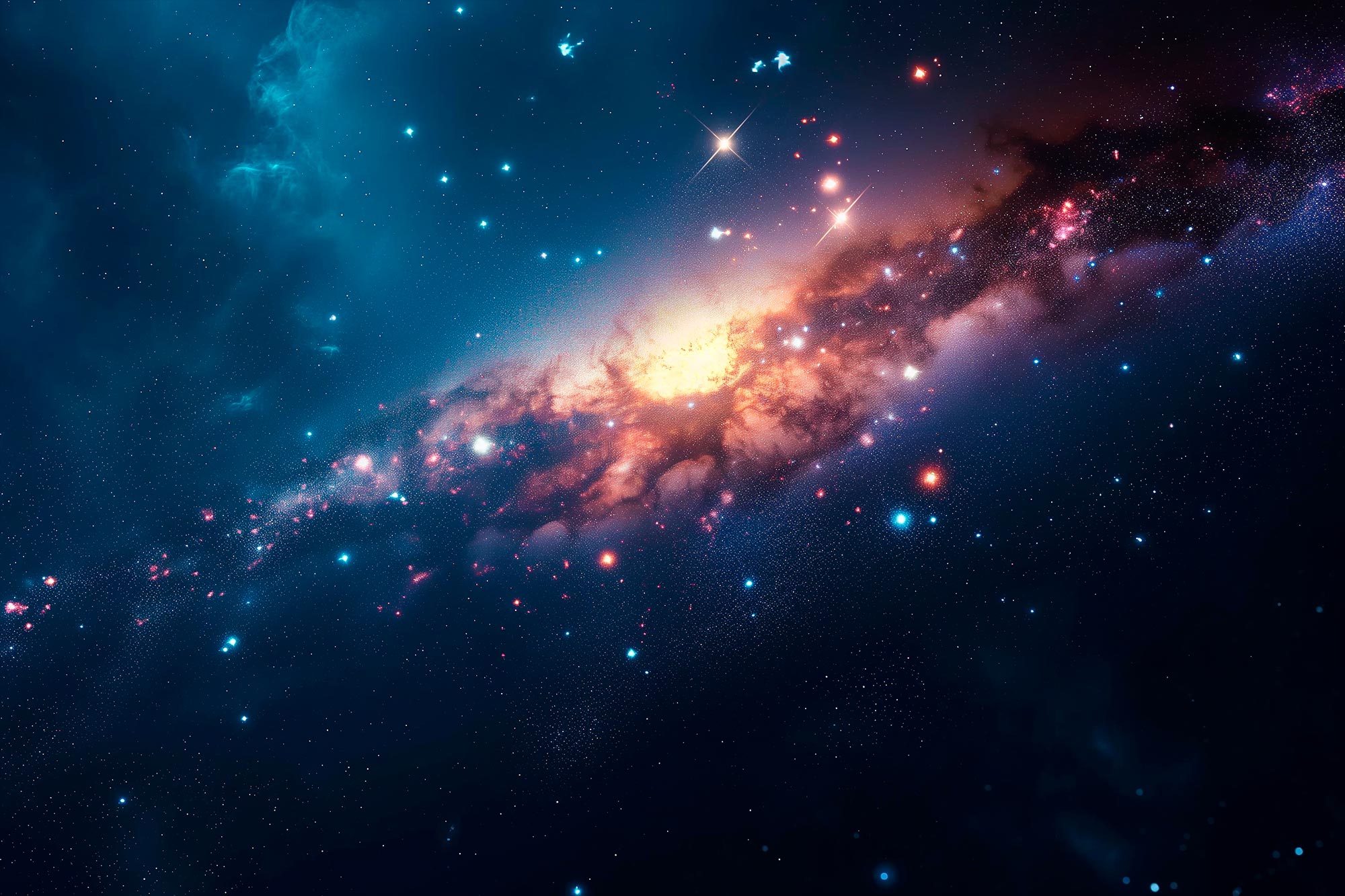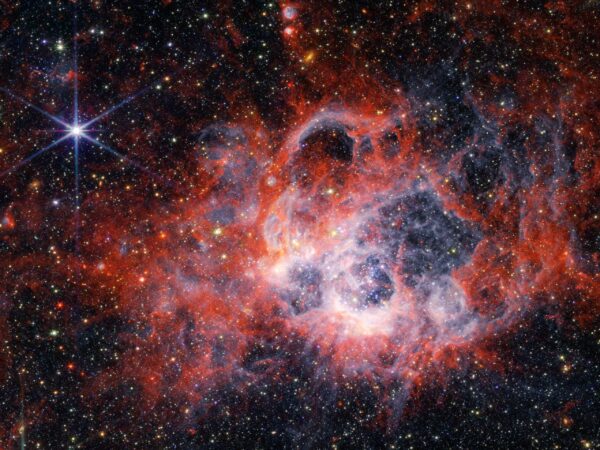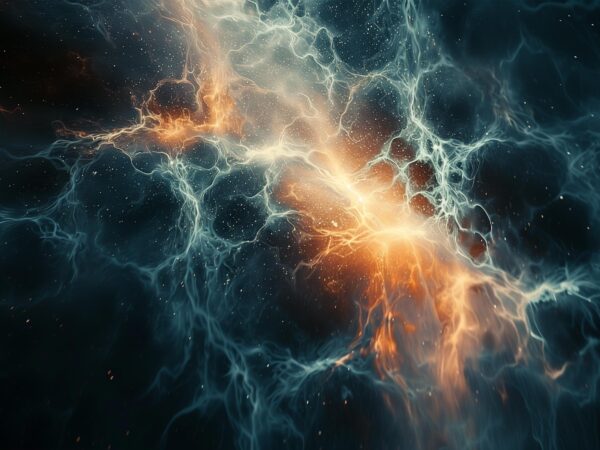
Groundbreaking JWST observations reveal the pivotal role of low-mass galaxies in the early universe’s reionization, challenging existing cosmic evolution theories.
Introduction
Scientists working with data from NASA’s James Webb Space Telescope (JWST) have obtained the first full spectra of some of the earliest starlight in the universe. The images provide the clearest picture yet of very low-mass, newborn galaxies, created less than a billion years after the Big Bang, and suggest the tiny galaxies are central to the cosmic origin story.
The Primordial Universe: A Transition From Darkness to Light
Normal matter in the universe started as a hot, dense fog made almost entirely of hydrogen and helium nuclei. As it expanded and cooled, lone protons and electrons started bonding, forming neutral hydrogen for the first time. Then, roughly 500 to 900 million years after the Big Bang, that neutral hydrogen began to separate again into ionized gas, spurring the creation of stars and galaxies and lifting the primordial fog so light could travel unimpeded through the cosmos for the first time.
“Something turned on that started pumping out very high energy photons into the intergalactic void,” explained Joel Leja, assistant professor of astronomy and astrophysics at Penn State. “These sources worked like cosmic lighthouses that burned off the fog of neutral hydrogen. Whatever this was, it was so energetic and so persistent, that the entire universe became re-ionized.”
Galactic Pioneers: The Role of Low-Mass Galaxies
By analyzing the spectra of young, low-mass galaxies, the scientists demonstrated that small galaxies were strong candidates for sparking the reionization of the universe by heating the dense primordial gas around them and ionizing the once-neutral hydrogen.
“If the other low-mass galaxies in the universe are as common and energetic as these, we think we finally understand the lighthouses that burned off the cosmic fog,” Leja said. “They were incredibly energetic stars in many, many tiny little galaxies.”
Charting the Cosmic Evolution: Future Directions
The Penn State team led the modeling for the UNCOVER survey, which targeted the large foreground galaxy cluster that lensed the tinier, more distant galaxies. The Penn State researchers analyzed all the small points of light in the survey to understand the object properties as well as their likely masses and distances.
Prior to these findings, there were number of hypotheses that identified other sources responsible for cosmic reionization, such as supermassive black holes; large galaxies with masses in excess of one billion solar masses; and small galaxies with masses of less than 1 billion solar masses. Researchers said confirmation of the hypothesis relating to low-mass galaxies proved particularly difficult, given their low luminosity, but the new findings offer the clearest evidence to date that low-mass galaxies played a central role in the reionization of the universe.
Reference
Reference: “Most of the photons that reionized the Universe came from dwarf galaxies” by Hakim Atek, Ivo Labbé, Lukas J. Furtak, Iryna Chemerynska, Seiji Fujimoto, David J. Setton, Tim B. Miller, Pascal Oesch, Rachel Bezanson, Sedona H. Price, Pratika Dayal, Adi Zitrin, Vasily Kokorev, John R. Weaver, Gabriel Brammer, Pieter van Dokkum, Christina C. Williams, Sam E. Cutler, Robert Feldmann, Yoshinobu Fudamoto, Jenny E. Greene, Joel Leja, Michael V. Maseda, Adam Muzzin, Richard Pan, Casey Papovich, Erica J. Nelson, Themiya Nanayakkara, Daniel P. Stark, Mauro Stefanon, Katherine A. Suess, Bingjie Wang and Katherine E. Whitaker, 28 February 2024, Nature.
DOI: 10.1038/s41586-024-07043-6
Authors and Acknowledgements
Bingjie Wang, a postdoctoral scholar in astrophysics, is the other Penn State co-author on the study. A full list of authors and their respective institutions is available on the published paper.
The researchers acknowledge funding and support from CNES, the Programme National Cosmology and Galaxies, CEA, the Cosmic Dawn Center, the Danish National Research Foundation, the Australian Research Council, the NOW, the European Commission’s and University of Groningen’s CO-FUND Rosalind Franklin program, the United States-Israel Binational Science Foundation, the U.S. National Science Foundation (NSF), the Ministry of Science & Technology, Israel and NOIRLab, which is managed by the Association of Universities for Research in Astronomy under a cooperative agreement with the NSF.
FAQs
What did the JWST observations reveal?
The JWST observations revealed the earliest starlight spectra, showcasing the pivotal role of low-mass galaxies in the universe’s dawn.
Why are low-mass galaxies important in the early universe?
Low-mass galaxies were found to be strong candidates for sparking the reionization of the universe, as they emitted a considerable amount of ionizing photons.
What are the future directions for this research?
The researchers aim to extend the study to a larger scale to confirm the distribution of galaxies in the universe and gain further insights into early star formation and galaxy evolution.




















